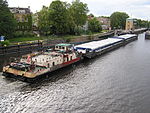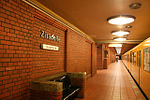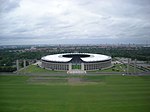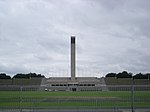Ruhleben internment camp
EngvarB from April 2017German Empire in World War IInternment camps in GermanyOlympic modern pentathlon venuesPrisoner-of-war camps in Germany ... and 5 more
Venues of the 1936 Summer OlympicsWartime association footballWorld War I civilian detainees held by GermanyWorld War I internment campsWorld War I sites in Germany

Ruhleben internment camp was a civilian detention camp in Germany during World War I. It was located in Ruhleben, a former Vorwerk manor 10 km (6.2 mi) to the west of Berlin, now split between the districts of Spandau and Charlottenburg-Wilmersdorf. The camp was originally a harness racing track laid out north of the Berlin-Hamburg Railway line in 1908.
Excerpt from the Wikipedia article Ruhleben internment camp (License: CC BY-SA 3.0, Authors, Images).Ruhleben internment camp
Freiheit, Berlin Spandau
Geographical coordinates (GPS) Address Nearby Places Show on map
Geographical coordinates (GPS)
| Latitude | Longitude |
|---|---|
| N 52.533333333333 ° | E 13.233333333333 ° |
Address
Klärwerk Ruhleben
Freiheit
13597 Berlin, Spandau
Germany
Open on Google Maps











